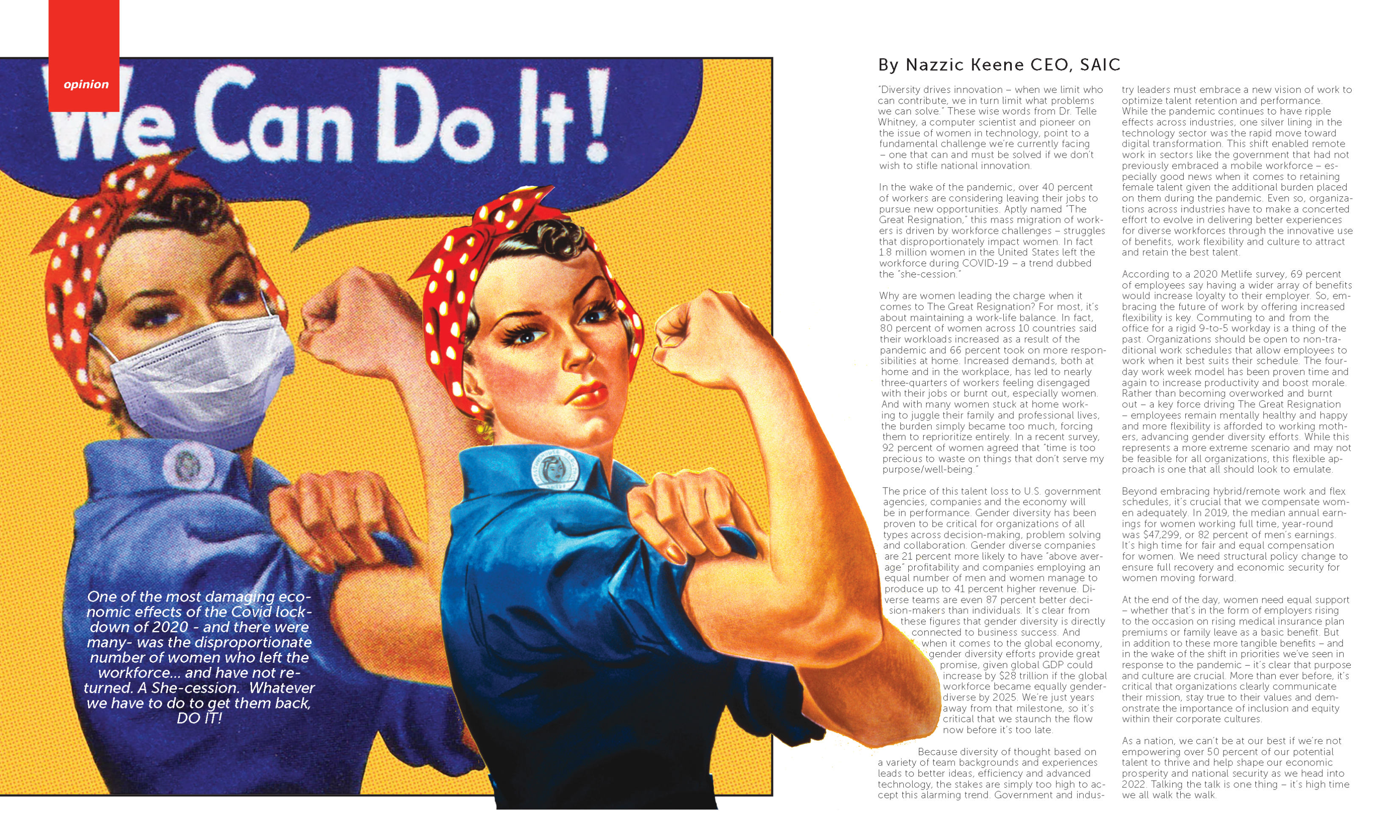
One of the most damaging economic effects of the Covid lockdown of 2020 – and there were many- was the disproportionate number of women who left the workforce… and have not re- turned. A She-cession. Whatever we have to do to get them back, DO IT!
“Diversity drives innovation – when we limit who can contribute, we in turn limit what problems we can solve.” These wise words from Dr. Telle Whitney, a computer scientist and pioneer on the issue of women in technology, point to a fundamental challenge we’re currently facing – one that can and must be solved if we don’t wish to stifle national innovation.
In the wake of the pandemic, over 40 percent of workers are considering leaving their jobs to pursue new opportunities. Aptly named “The Great Resignation,” this mass migration of workers is driven by workforce challenges – struggles that disproportionately impact women. In fact 1.8 million women in the United States left the workforce during COVID-19 – a trend dubbed the “she-cession.”
Why are women leading the charge when it comes to The Great Resignation? For most, it’s about maintaining a work-life balance. In fact, 80 percent of women across 10 countries said their workloads increased as a result of the pandemic and 66 percent took on more responsibilities at home. Increased demands, both at home and in the workplace, has led to nearly three-quarters of workers feeling disengaged with their jobs or burnt out, especially women. And with many women stuck at home working to juggle their family and professional lives, the burden simply became too much, forcing them to reprioritize entirely. In a recent survey, 92 percent of women agreed that “time is too precious to waste on things that don’t serve my purpose/well-being.”
The price of this talent loss to U.S. government agencies, companies and the economy will be in performance. Gender diversity has been proven to be critical for organizations of all types across decision-making, problem solving and collaboration. Gender diverse companies are 21 percent more likely to have “above average” profitability and companies employing an equal number of men and women manage to produce up to 41 percent higher revenue. Diverse teams are even 87 percent better decision-makers than individuals. It’s clear from these figures that gender diversity is directly connected to business success. And when it comes to the global economy, gender diversity efforts provide great promise, given global GDP could increase by $28 trillion if the global workforce became equally gender-diverse by 2025. We’re just years away from that milestone, so it’s critical that we staunch the flow now before it’s too late. Because diversity of thought based on a variety of team backgrounds and experiences leads to better ideas, efficiency and advanced technology, the stakes are simply too high to accept this alarming trend. Government and industry leaders must embrace a new vision of work to optimize talent retention and performance. While the pandemic continues to have ripple effects across industries, one silver lining in the technology sector was the rapid move toward digital transformation. This shift enabled remote work in sectors like the government that had not previously embraced a mobile workforce – especially good news when it comes to retaining female talent given the additional burden placed on them during the pandemic. Even so, organizations across industries have to make a concerted effort to evolve in delivering better experiences for diverse workforces through the innovative use of benefits, work flexibility and culture to attract and retain the best talent.
According to a 2020 Metlife survey, 69 percent of employees say having a wider array of benefits would increase loyalty to their employer. So, embracing the future of work by offering increased flexibility is key. Commuting to and from the office for a rigid 9-to-5 workday is a thing of the past. Organizations should be open to non-traditional work schedules that allow employees to work when it best suits their schedule. The fourday work week model has been proven time and again to increase productivity and boost morale. Rather than becoming overworked and burnt out – a key force driving The Great Resignation – employees remain mentally healthy and happy and more flexibility is afforded to working mothers, advancing gender diversity efforts. While this represents a more extreme scenario and may not be feasible for all organizations, this flexible approach is one that all should look to emulate.
Beyond embracing hybrid/remote work and flex schedules, it’s crucial that we compensate women adequately. In 2019, the median annual earnings for women working full time, year-round was $47,299, or 82 percent of men’s earnings.
It’s high time for fair and equal compensation for women. We need structural policy change to ensure full recovery and economic security for women moving forward.
At the end of the day, women need equal support – whether that’s in the form of employers rising to the occasion on rising medical insurance plan premiums or family leave as a basic benefit. But in addition to these more tangible benefits – and in the wake of the shift in priorities we’ve seen in response to the pandemic – it’s clear that purpose and culture are crucial. More than ever before, it’s critical that organizations clearly communicate their mission, stay true to their values and demonstrate the importance of inclusion and equity within their corporate cultures.
As a nation, we can’t be at our best if we’re not empowering over 50 percent of our potential talent to thrive and help shape our economic prosperity and national security as we head into 2022 talking the talk is one thing – it’s high time
we all walk the walk.


